Tony Corbell - Tamron
Tony Corbell - Tamron
Tony Corbell - Tamron
You also want an ePaper? Increase the reach of your titles
YUMPU automatically turns print PDFs into web optimized ePapers that Google loves.
Advertisement<br />
<strong>Corbell</strong>’s philosophy of photographing people is easy to<br />
state, but requires considerable talent and perseverance<br />
to execute. He says, “My goal is simply to show people as they<br />
are, doing what they do. But you have to make it exciting–you<br />
have to make it insightful. You might be able to fulfill the letter of<br />
your contract on the first or second shot, but getting it right in<br />
terms of art and expression may take three of four shots–or<br />
forty. I call a lot of what I do ‘creative contemporary portraits’<br />
and the key element here is creativity, which means understanding<br />
your subjects and relating to them. That’s one reason<br />
I Iove to photograph musicians--they’re expressive without<br />
being self-conscious.”<br />
Advertisement<br />
The <strong>Tamron</strong> SP AF28-75mm f/2.8 Di MacroLens:<br />
A MASTERPIECE OF OPTICAL DESIGN<br />
TONY<br />
CORBELL<br />
TAMRON: A MASTERPIECE OF OPTICAL DESIGN<br />
<strong>Tony</strong> <strong>Corbell</strong> of San Diego, California is a highly regarded,<br />
well established professional photographer well known among<br />
pro shooters and students of photography from coast to<br />
coast. His specialty is taking pictures of people--incisive<br />
environmental portraits of everyone from musicians and<br />
celebrities to lawyers and bank presidents. He also known<br />
for his inspired photojournalistic coverage of society weddings<br />
shot in such posh places as Beverly Hills. And he creates<br />
commercial and editorial images that rise to the level of fine<br />
art. Like many top photographers, <strong>Corbell</strong> has a discriminating<br />
eye for dynamic composition, a well-developed instinct for<br />
capturing decisive moments, and a finely-tuned sense of<br />
color balance. But above all he is a master of light–it is<br />
his brilliant use of lighting that distinguishes his work and<br />
defines his unique style.<br />
Unlike most successful photographers, <strong>Corbell</strong> did not begin his<br />
career as a teenage photo hobbyist. Although he was always<br />
visually sensitive and observant, he didn’t really get into<br />
photography until his mid 20s--and then he was pushed into the<br />
pool, so to speak, and discovered he was a natural swimmer. “At<br />
age 24,I was directing and producing a kind of silly late night talk<br />
show on cable TV that was basically a time filler. Out of the blue,<br />
my photographer brother-in-law, Raymond Taylor, asked me to take<br />
a portrait of a high school senior. He encouraged me, assuring<br />
me that I had a pretty good eye for framing, and so I took the<br />
shot, which I successfully sold. I had never thought of photography<br />
as a career--I had never even owned a camera–and here<br />
I was, a pro that had never been an amateur!”<br />
Shortly afterward, <strong>Corbell</strong> bought his first camera, a Hasselblad<br />
500C, and within three months he was shooting fulltime every<br />
day. After about a year of on-the-job training and commercial<br />
success as a hard-working portrait photographer, he decided to<br />
enter some of his pictures in a local print competition. He won<br />
in three categories--best portrait of a woman, a child and a<br />
family. Out of this gratifying but seemingly minor triumph, something<br />
truly remarkable evolved that was to shape <strong>Corbell</strong>’s entire<br />
life and career. A visiting Nigerian businessman saw the contest,<br />
contacted <strong>Corbell</strong>, and made him a business proposition.<br />
It seems that back in 1979 there were no color photo studios<br />
in Nigeria. Once a year, a pro from the U.K. would travel to<br />
Lagos, the capital, and take pictures of top officials and<br />
well-to-do families.That was it as far as color photography<br />
was concerned.The businessman proposed that <strong>Corbell</strong> set<br />
up a color photo studio in Lagos and teach local people how<br />
to run it. He was to be paid a fair day rate for his services<br />
plus a percentage of the sales, and was given carte blanche<br />
to order any equipment he needed.<br />
<strong>Corbell</strong> accepted the once-in-a-lifetime offer. He then spent<br />
six weeks in Nigeria taking pictures of heads of state and<br />
government officials, in both formal western attire and colorful<br />
traditional Nigerian dress, while his shooting techniques and<br />
setups were carefully documented by the studio staff. After<br />
<strong>Corbell</strong> returned to the U.S., his Nigerian pictures were seen<br />
and admired by the Professional Photographers of America<br />
(PP of A) and he received much favorable publicity. By the early<br />
80’s he had established his first real studio in Midland,<br />
Texas, which he calls “the white collar city of the oil industry.”<br />
While there, he photographed George Bush, Sr. on several<br />
occasions, and these memorable portraits generated even<br />
more publicity and business.<br />
Despite his increasing technical competence and notable<br />
commercial success, by 1985 <strong>Corbell</strong> sensed something was<br />
amiss. “I felt stifled--I was in a rut--and then in late 1985 I had<br />
an epiphany. I met my mentor, Dean Collins, a true genius, a l<br />
egend among photographers, and one of the great photographic<br />
teachers of all time. I sold my studio and moved to<br />
Like all <strong>Tamron</strong> Di (Digitally Integrated) -series lenses, the<br />
<strong>Tamron</strong> SP AF28-75mm Di has been especially formulated<br />
to meet the more stringent demands of digital photography in<br />
order to assure outstanding image quality with both digital media<br />
and film. To achieve this exceptional level of performance<br />
in a super-compact, high speed (F/2.8) constant-aperture<br />
zoom, <strong>Tamron</strong>’s optical designers used LD glass to reduce<br />
chromatic aberration and peripheral light falloff, high-index<br />
XR glass to enhance sharpness while while reducing size and<br />
weight, and an aspherical element to compensate for spherical<br />
aberration and distortion. The result is unsurpassed imaging<br />
performance in the smallest and lightest zoom lens ever<br />
made in this class.<br />
With a fast f/2.8 aperture over its entire zoom range, the<br />
<strong>Tamron</strong> 28-75mm Di lens allows shooting in low light, and<br />
shooting at extended distances with flash even at the tele<br />
end. And it focuses continuously down to 13 inches at all<br />
focal lengths, a true macro magnification of 1:3.9 at<br />
75mm, while maintaining image quality of the highest<br />
order. Contributing to its ease of use are its excellent balance<br />
and handling characteristics, with extra-wide, well-textured<br />
zoom and manual-focusing controls, and large, legible<br />
white-on-black numerical scales. Unlike most lenses<br />
optimized for sharpness, the <strong>Tamron</strong> 28-75mm Di delivers a<br />
beautifully blurred quality in out-of-focus areas of the image<br />
that draws the eye to the subject. Or, as the Japanese<br />
would say, it has very good bokeh.<br />
The <strong>Tamron</strong> SP AF28-75mm f/2.8 Di lens is only 3.6 inches<br />
long at the 28mm setting and extends to a still-very-compact<br />
4.9 inches. It weighs 18 ounces, and is available in mounts<br />
for Canon, Minolta, Nikon and Pentax autofocus SLRs,<br />
both 35mm and digital. Other features include: 16-element,<br />
14-group optical construction, 7-bladed diaphragm, zoom<br />
lock mechanism to prevent the barrel from extending<br />
unnecessarily, and a flower-shaped lens hood designed to<br />
minimize stray light at all focal lengths.<br />
If you’re looking for a top-quality universal zoom lens for<br />
your digital or film SLR, this is one to put on your short<br />
list. As <strong>Tony</strong> <strong>Corbell</strong> said, he’s used to shooting with Zeiss<br />
lenses on Hasselblads and he’s quite taken with how the<br />
<strong>Tamron</strong> 28-75mm Di performs.Chances are mighty good<br />
you will be too.
Advertisement<br />
Advertisement<br />
San Diego to work with him. He was a tremendously talented<br />
commercial photographer, but he was also the best photo<br />
educator in the country. He was an unparalleled master of<br />
lighting, with a full and complete understanding of being in<br />
control of light. We would talk about light for hours, drawing<br />
diagrams and coming up with theoretical explanations. We<br />
would sit in a restaurant and look at the light falling on a salt<br />
shaker and analyze why the shadow was hard or soft and why<br />
it fell where it did. We also did lots of hands-on experiments.<br />
Eventually, we crystallized our observations and theories into<br />
a series of books and videos called Fine Light. We also set<br />
up four separate companies--a lecture company, a studio, a<br />
video company, and a research and development company<br />
for lighting devices. As you might imagine, we were pretty<br />
busy. In ‘86, we gave 52 lectures for Kodak all over the U.S.<br />
and in six foreign countries. We were a veritable think tank,<br />
but we also took lots of pictures, everything from hotels to<br />
motorcycles. Of course we also did lots of R &D shooting in<br />
developing the new soft boxes we marketed.”<br />
ing at Brooks, my own creativity in areas such as wedding<br />
photojournalism was enhanced enormously. Looking at and<br />
really getting into the amazing images created by these<br />
students not only pushed my own creativity to a new level, it<br />
also energized my creative drive.”<br />
Another important lesson <strong>Corbell</strong> learned at Brooks is that<br />
education is an ongoing process. “One of my colleagues, an<br />
excellent landscape photographer, recently asked a simple<br />
question that brought me up short. ‘How come photographers<br />
don’t go out and practice with their cameras?’ I thought about<br />
that for a while and decided that she was right. So I gave myself<br />
an assignment which turned into a series of images I call ‘My<br />
Life as a Fork.’ What I did was take an ordinary fork, some red<br />
poster board and different lights to see how much I could do<br />
graphically with these simple elements. By thinking creatively<br />
and trying to see differently, I created unique shadow patterns<br />
that elicit strikingly different feelings and emotions. This goes<br />
back to the three essential aspects of light I taught my students<br />
at Brooks--light quality, light quantity, and light direction.”<br />
All this experience and exposure, plus a natural affinity, eventually<br />
led <strong>Corbell</strong> to an entirely new aspect of his<br />
multifaceted career---teaching. He knew Ernie Brooks, founder<br />
of the famed Brooks Institute of Photography, and let him<br />
know he was interested in a teaching position. Despite <strong>Corbell</strong>’s<br />
lack of academic credentials, Brooks hired him within 48 hours<br />
based on his exemplary reputation and impressive track<br />
record. His teaching stint at Brooks lasted four years.<br />
As any good teacher can tell you, teaching is one of the most<br />
effective ways to enhance the depth of your knowledge, and<br />
<strong>Corbell</strong> emphatically agrees. “When you think you know something,”<br />
he says, “just try to teach it and you’ll immediately come<br />
up against your own limitations. The questions that you don’t<br />
know to ask yourself are invariably the ones the students will<br />
ask. These are the questions that force you to stretch, and<br />
that’s how you gain a more profound understanding. By teach-<br />
The next major shift in the amazing career of <strong>Tony</strong> <strong>Corbell</strong><br />
came in 1993 when he got a call from Skip Cohen of<br />
Hasselblad offering him an executive spot as Director of<br />
Corporate Communications at Hasselblad. He accepted on<br />
one condition: That he could continue to shoot and continue<br />
to teach. “Happily, they agreed,” he says, “and from 1993 to<br />
2000, I was one-third corporate executive, one-third teacher,<br />
and one-third photographer. I really grew a lot during this<br />
period because I got to interact with really first-class<br />
photographers like Mary-Ellen Mark, Greg Heissler, and Jay<br />
MaiseI and look at their outstanding work. I would visit their<br />
studios, meet them at press conferences and conventions,<br />
and talk with them about their methods, goals, and directions.<br />
As a result, I began to see a bigger picture of what was possible<br />
and widened my perspective. You might say I acquired more<br />
peripheral vision.”<br />
When <strong>Corbell</strong> finally left Hasselblad he felt re-energized and<br />
determined to reinvent himself as a photographer. “When an<br />
old friend said ‘I’m so glad that you picked up a camera<br />
again,’ I knew I had made the right decision. I had built-in<br />
clients at Hasseslblad, but now I had a new understanding of<br />
the commercial quest. I understood that you needed to<br />
market yourself, to make new connections, to be an active<br />
seeker of things. I knew I wanted to go after work that excited<br />
and intrigued me. I like giving people what they expect, but I<br />
also want to give them something they don’t expect. If you<br />
consistently do the latter, you are growing as a photographer and<br />
growing your business. In short, you are exceeding<br />
expectations.”Over the past six months or so, <strong>Tony</strong> <strong>Corbell</strong> has<br />
returned to one of his early specialties--shooting weddings--but<br />
with a vibrant new twist. He now concentrates on high-end<br />
weddings in such well-heeled venues as Beverly Hills, and his<br />
approach is that of an inspired photojournalist. “To shoot a<br />
wedding in this way, you have to gain the absolute trust of the<br />
bride and groom and get them to allow you to tell the intimate<br />
and honest story of their special day--everything from the<br />
bride’s hair being coiffed to driving away on their honeymoon.<br />
Unlike other photographers, I don’t even deliver proofs, but a<br />
finished story book album of the day, so you really have to get<br />
their commitment by making them feel this is the best choice<br />
for them. Of course it helps to have a solid reputation and an<br />
empathetic personality. Most photographers also charge a set<br />
price for a certain number of pictures, but I don’t work that<br />
way. I include digital montages, and may include 300 or more<br />
images in the album. And we don’t miss anything. We do our<br />
homework, so we get engaging and natural images of all the<br />
special people, as well as capturing great moments like the<br />
flower girl kissing the ring bearer. It is significant that this new<br />
wedding business has been promoted entirely by word of<br />
mouth and referrals by bridal consultants.”<br />
While <strong>Tony</strong> <strong>Corbell</strong> still shoots about 30 percent of his images<br />
on film, he shoots the majority of his current work, about 70<br />
percent, digitally, with a Fuji Finepix Pro S2 camera and<br />
<strong>Tamron</strong> Di lenses, which are designed to meet the demands<br />
of digital photography.“For wedding portraits, the first lens I<br />
grab is the <strong>Tamron</strong> Di 180mm f/3.5 Macro. I know that<br />
optically it’s optimized for close work, but it is exquisitely<br />
sharp at all distances and produces great pictures. With the<br />
1.5 multiplication factor of the Fuji S2, it’s equivalent to a<br />
270mm lens on 35mm and it really separates the subject<br />
from the background, especially when shooting wide<br />
open.”<strong>Corbell</strong> also has high praise for the 28-75mm f/2.8<br />
<strong>Tamron</strong> Di, a lens he often leaves on the camera. “I can cover<br />
a whole wedding with this one lens, which means I don’t have<br />
to change lenses--and fewer lens changes mean a cleaner<br />
image sensor. Even more important, when I shoot with this<br />
lens, or other <strong>Tamron</strong> Di lenses, I don’t have to go into<br />
Photoshop and enhance the images with a 20-60-0 unsharp<br />
mask. There is less visible flare--it’s like looking at the world<br />
after you’ve just cleaned your glasses. <strong>Tamron</strong> lenses are<br />
physically very well designed too--easy and comfortable to handle<br />
and hold onto. I also use a 14mm <strong>Tamron</strong> for wide-angle shots-–it’s<br />
not a Di lens, but it has unbelievable coverage and remarkable<br />
evenness of illumination with no falloff at the corners.<br />
I am frankly amazed at what <strong>Tamron</strong> lenses can do. And<br />
remember I am a Hasselblad shooter who is used to<br />
working with Zeiss lenses. I’m not the average photographer–I<br />
understand how optics work. And I am delighted with the<br />
performance of <strong>Tamron</strong> lenses, which I can only describe<br />
as outstanding.”<br />
As my enlightening and inspiring interview with the incredible<br />
<strong>Tony</strong> <strong>Corbell</strong> was winding down, he told me he was heading off<br />
to Pasadena. “To shoot a society wedding?.” I asked. “No,”<br />
he said, “I’m going to take a few advanced Photoshop courses.<br />
If you want; to be a leader in this profession you’ve got to say<br />
on top of our industry” A commitment to continuing education,<br />
an unquenchable desire to expand his capabilities, and an<br />
openness to new ideas--these things, plus a wealth of talent<br />
and experience, are what make <strong>Tony</strong> <strong>Corbell</strong> one of the best<br />
in the business. <strong>Corbell</strong> has just come out out with a new<br />
DVD series on lighting called “The Power of Light” and a new<br />
line of soft boxes of the same name. For more information on<br />
both, go to www.corbellproductions.com.<br />
www.tamron.com




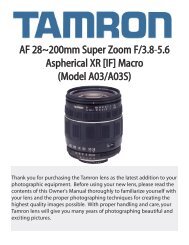

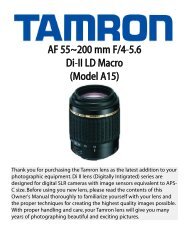
![SP AF 300mm F/2.8 LD [IF] for Canon (Model 360EE) - Tamron](https://img.yumpu.com/27036206/1/190x245/sp-af-300mm-f-28-ld-if-for-canon-model-360ee-tamron.jpg?quality=85)
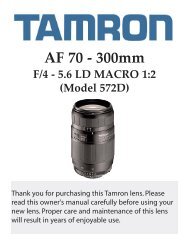
![SP AF17-50mm F/2.8 XR Di LD Aspherical [IF] - Tamron](https://img.yumpu.com/27036204/1/190x245/sp-af17-50mm-f-28-xr-di-ld-aspherical-if-tamron.jpg?quality=85)
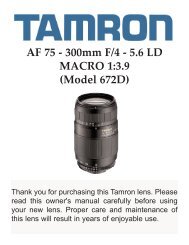
![AF 18~250 mm F/3.5-6.3 Di-II LD Aspherical [IF] - Tamron](https://img.yumpu.com/27036201/1/190x245/af-18250-mm-f-35-63-di-ii-ld-aspherical-if-tamron.jpg?quality=85)
![AF28-300mm F/3.5-6.3 XR Di LD Aspherical [IF] Macro ... - Tamron](https://img.yumpu.com/27036194/1/190x245/af28-300mm-f-35-63-xr-di-ld-aspherical-if-macro-tamron.jpg?quality=85)

![SP AF 14mm F/2.8 Aspherical [IF] (Model 69E) - Tamron](https://img.yumpu.com/27036192/1/190x245/sp-af-14mm-f-28-aspherical-if-model-69e-tamron.jpg?quality=85)
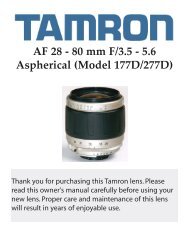
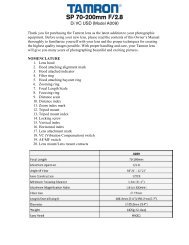
![SP AF 17~50 mm F/2.8 XR Di-II LD Aspherical [IF] (Model ... - Tamron](https://img.yumpu.com/27036181/1/190x245/sp-af-1750-mm-f-28-xr-di-ii-ld-aspherical-if-model-tamron.jpg?quality=85)